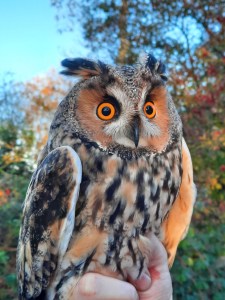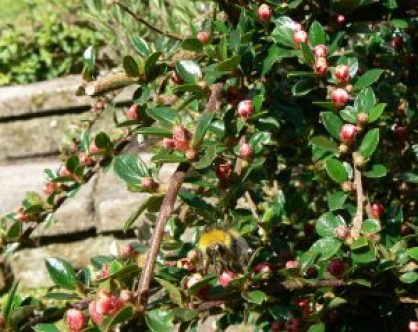Above: December Moth. All photos © Gordon Redford
During the 10 years that I have been recording moths at Linford Lake Nature Reserve (LLNR), I have usually not run traps in November and December because the effort in setting traps up on late afternoons, transportation on foot of 12V batteries, then checking traps daily early mornings during the wet and windy months of the year when fewer moths are around anyway was not really worth it. The installation on site of the permanent moth trap running off the mains electricity in August 2019 though has changed the efforts in/returns out balance. December 2019 records of 52 moths counted and 10 species recorded was a good start and had me thinking that perhaps I should have made more effort in the previous 8 years. December 2020, with the trap running 30 of the 31 days, was a disappointment with just 14 moths and 5 species recorded and has had me thinking that maybe I was right in the first place.
The 5 were December Moth, Winter Moth, Pale Brindled Beauty, Mottled Umber and Dark Chestnut. Interestingly, all were singletons except the December Moth for whom 10 were counted. Last year, December Moth numbered just 6. The weather was pretty dire in December with more water on the site than I have ever seen in the 25 years that I have been visiting the site. The photographs below taken on Christmas Eve shows the boardwalk from the car park on to the field at the back of the visitor centre and the field behind the centre.

Boardwalk from car park on to field at back of Centre
It will be interesting to see what effect this extensive flooding will have on moth numbers next year.
Summary Of The Moths Recorded At Linford Lakes Nature Reserve 2020
Moth traps were run at Linford Lakes Nature Reserve on almost all of the 366 nights of 2020. The traps were the large box on legs with a 125W Mercury Vapour bulb powered by mains electricity, a Robinson trap with a 125W Mercury vapour Bulb powered by a generator and three Skinner type traps, 2 with 40W actinic tubes and one with 2 x 2W LED lights powered by batteries. The large box on legs was used almost consistently, the Robinson for about half of the year and the Skinners occasionally.
The total number of moths counted in 2020 was 18,059 and is the highest number recorded there in the ten years that I have been keeping regular records. 387 species were recorded which is just 2 less than the highest number of species recorded which was in 2019 from a total moth count of 17, 935.
The 387 species recorded in 2020 comprised 133 micro moths and 254 macro moths. 33 species were new to the site so that the total number of species now recorded at LLNR is now 560. Excluding Acentria ephemerella, a micro moth which swarms on warm nights and are often too numerous to count, the most common species recorded were Common Wainscot with 1,703 moths counted followed by Large Yellow Underwing with 927.
The Common Wainscot numbers were a great surprise. Moth numbers are known to have peaks and troughs, good years and poor years, but this number, some 5 times more than the previous best year, had me checking to make sure that I had not double- or treble-pressed a number when entering the records but no, there were no errors on my part. 188 recorded on 18th August was the most in one night. The caterpillars feed on grasses including Common Couch and Cock’s-foot which are abundant at LLNR.
Poplar Hawk-moths had their best year ever with 321 counted. The previous best was 235 in 2017. Elephant Hawk-moths too had their best year ever with 50 being counted between 23rd May to 29th July.
The Poplar Hawk-moth season in 2020 began on 3rd May and the last was caught on 11th September. At LLNR over the ten years of recording, the species has consistently produced 2 generations of moths during the summer.
At the other end of the scale, species whose numbers had dropped significantly this year were July Highflier and Old Lady.
The July Highflier is one of three moths with the name highflier. The others are the May Highflier and the Ruddy Highflier and, yes, they fly high around trees and bushes. The July Highflier is very variable and often catches me out. It is also quite skittish, taking off readily. Caterpillars feed on sallows and willows amongst others so LLNR is well suited to their needs. 12 were recorded in 2020 whereas in the previous 6 years their numbers have been in the 30’s and 40’s.
The Old Lady was absent in 2020 having been present in the previous 6 years. Her numbers have never been high, mostly in single figures. The moth is known to come to sugar more readily than to light. Sugaring is when a sweet concoction is prepared and painted on to tree trunks, wooden gates, posts and was used in the past before light traps to attract moths. I have sugared at LLNR in previous years but did not do so last year.
Of the 33 new moths recorded at LLNR in 2020, 20 were micro moths and 13 macro moths. There is evidence that due to climate change some species are expanding their ranges and three of the macro moths could be among that group. Dotted Fan-foot, Dark Crimson Underwing and Dewick’s Plusia form the trio.
Dotted Fan-foot has been restricted to the wetlands of East Anglia, Essex and the Thames Estuary but 3 turned up, 2 on the 8th July and another on the 17th.
The caterpillars feed on rushes and sedges and the habitat at LLNR is just right for this moth. My hopes are high that it might find a (6) foothold there.
The Dark Crimson Underwing is described in The Atlas of Britain and Ireland’s Larger Moths as “a resident and scarce immigrant confined to the New Forest and a few woods in Hampshire and south Wiltshire with signs of a recent increase in range”. It appeared on 24th July and the photograph below, taken on the day, shows a rather worn and travelled specimen,
Its preferred habitat is large tracts of mature Oak woodland but nonetheless a good moth to have called in.
The third newcomer was Dewick’s Plusia. I recorded 2 of these at home for the first time in September 2019. The Field Guide to the Moths of Great Britain and Ireland lists the moth as an immigrant and possible recent colonist.
It goes on to say the moth has been recorded in May and July-October and the flight season in mainland Europe, April-November. My records for LLNR in 2020 are 26th April and 29th July and I have wondered whether the earlier record may be evidence of breeding locally. It will be interesting to see if and when they turn up in 2021.
2020 was a good year for moths at LLNR. If anyone would like a list of the moths recorded last year or, indeed, all my records for LLNR or would like to join me in opening up the traps early morning in 2021 (Covid permitting) , please contact me on gordonredford@hotmail.com.
Gordon Redford
20 January 2021













































































































































































 The fantastic butterfly season during 2018 was always going to be a difficult act to follow and although some species were down in 2019 the year still held some great success stories. Among 2019’s achievements was a very welcome spike in Peacock numbers, a Painted Lady invasion, the continued colonisation by Dark Green Fritillaries and the incredible news of the first Chequered Skippers to emerge in the wild in the county for nearly half a century.
The fantastic butterfly season during 2018 was always going to be a difficult act to follow and although some species were down in 2019 the year still held some great success stories. Among 2019’s achievements was a very welcome spike in Peacock numbers, a Painted Lady invasion, the continued colonisation by Dark Green Fritillaries and the incredible news of the first Chequered Skippers to emerge in the wild in the county for nearly half a century.

 The world’s rarest wader has been thrown a lifeline after two Spoon-billed Sandpiper chicks hatched at WWT Slimbridge in Gloucestershire.
The world’s rarest wader has been thrown a lifeline after two Spoon-billed Sandpiper chicks hatched at WWT Slimbridge in Gloucestershire. Making a beetle stack is a way of providing beetles and many other insects with shelter through the winter. This stack is simple to make and costs next to nothing, but will make a world of difference to garden wildlife.
Making a beetle stack is a way of providing beetles and many other insects with shelter through the winter. This stack is simple to make and costs next to nothing, but will make a world of difference to garden wildlife.






 A new survey has revealed that the corncrake population has decreased by over 30% in the last 5 years.
A new survey has revealed that the corncrake population has decreased by over 30% in the last 5 years.









 Early return to breeding areas is widely acknowledged to be ‘a good thing’ but why? Some people suggest that early migrants can choose the best territories, others argue that early chicks have a disproportionately high chance of fledging but there are other explanations too. In their paper in Ecology & Evolution, Catriona Morrison and her colleagues ask how much of the advantage of being an early migrant could be associated with having an option to nest again, if the first attempt fails.
Early return to breeding areas is widely acknowledged to be ‘a good thing’ but why? Some people suggest that early migrants can choose the best territories, others argue that early chicks have a disproportionately high chance of fledging but there are other explanations too. In their paper in Ecology & Evolution, Catriona Morrison and her colleagues ask how much of the advantage of being an early migrant could be associated with having an option to nest again, if the first attempt fails.







